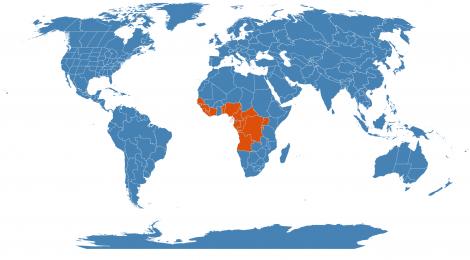Accession Data:
Spathodea campanulata P.Beauv.
- Common Name: African Tulip Tree
- Family: Bignoniaceae Juss.
- Country of Origin: W. Trop. Africa to Uganda and Angola

- Habitat: cultivated ornamental street tree in tropics
- Description: This spectacular, fast-growing tree grows to about 80 ft (24 m) tall. The large, flat clusters of velvety, bronze-green buds and big, nectar-rich, orange-red flowers with yellow frilly edges are borne through spring and summer. The leaves are bronze when young, maturing to deep glossy green. The fruit are 8 in (20 cm) long.
- Uses: Edible: Winged seeds are reported to be edible.
Medicinal: Bark is commonly used as a dressing for ulcers and skin diseases, applied dried, pulverized, or as fresh inner bark. A leaf decoction is used as lotion. In Africa, the stem bark is used as a paste for wound healing. In Senegal, bruised leaves and flowers are applied to wounds. In Gabon, flowers are applied to ulcers. In Southern Nigeria, leaves used for convulsions.In Gold Coast, bark decoction taken for constipation and gastrointestinal problems and dysentery. Cold infusion of leaves used for urethral inflammation. In Ghana, the stem bark and leaf used for treatment of dyspepsia and peptic ulcer; leaf, root bark and fruit used for arthritis and fractures; the stem bark used for toothaches and stomachaches; root bark seed used for stomach ulcers. In Rwanda, decoction of stem bark used for diabetes. In Ayurveda, used for kidney diseases.
Studies have shown extracts to have anti-microbial, hypo-glycemic, anti-malarial, healing activity for burn wounds, antifungul, analgesic/anti-inflammatory, abillity to absorb UV radiation, anti-convulsant/ glycoside, and nephroprotective properties. 5
- IMPORTANT NOTE: Plant Uses are for informational purposes only. EEB Greenhouses assume no responsibility for adverse effects from the use of any plants referred to on this site. Always seek advice from a professional before using any plant medicinally.
- Culture: Prefers acidic, rich, well-drained sandy soil, sunny position. Propagation is usually from seed, which can be variable.
- USDA Zone: 11-12
Accession Data:
- Accession # 199200447
- Source: Unknown
- Accession Date: 12-31-1992
- Bench: 1116 - AFR:Ground Bed 2 SE
- Currently: active - healthy
- Qty: 3 confirmed on 02-26-2025
Classification:
- Division: Magnoliophyta
- Class: Magnoliopsida
- SubClass: euasterid I
- Order: Lamiales
- SubOrder:
- Family: Bignoniaceae
- SubFamily:
- Tribe: Tecomeae
- SubTribe:
Flowering Data:
This accession has been observed in bloom on:| Year | Jan | Feb | Mar | Apr | May | Jun | Jul | Aug | Sep | Oct | Nov | Dec | ||||||||||||||||||||||||||||||||||||||||
|---|---|---|---|---|---|---|---|---|---|---|---|---|---|---|---|---|---|---|---|---|---|---|---|---|---|---|---|---|---|---|---|---|---|---|---|---|---|---|---|---|---|---|---|---|---|---|---|---|---|---|---|---|
| 2025 | ||||||||||||||||||||||||||||||||||||||||||||||||||||
| 2024 | ||||||||||||||||||||||||||||||||||||||||||||||||||||
| 2023 | ||||||||||||||||||||||||||||||||||||||||||||||||||||
| 2022 | ||||||||||||||||||||||||||||||||||||||||||||||||||||
| 2021 | ||||||||||||||||||||||||||||||||||||||||||||||||||||
| 2020 | ||||||||||||||||||||||||||||||||||||||||||||||||||||
| 2019 | ||||||||||||||||||||||||||||||||||||||||||||||||||||
| 2018 | ||||||||||||||||||||||||||||||||||||||||||||||||||||
| 2017 | ||||||||||||||||||||||||||||||||||||||||||||||||||||
| 2016 | ||||||||||||||||||||||||||||||||||||||||||||||||||||
| 2015 | ||||||||||||||||||||||||||||||||||||||||||||||||||||
| 2014 | ||||||||||||||||||||||||||||||||||||||||||||||||||||
| 2013 | ||||||||||||||||||||||||||||||||||||||||||||||||||||
| 2012 | ||||||||||||||||||||||||||||||||||||||||||||||||||||
| 2011 | ||||||||||||||||||||||||||||||||||||||||||||||||||||
| 2010 | ||||||||||||||||||||||||||||||||||||||||||||||||||||
| 2009 | ||||||||||||||||||||||||||||||||||||||||||||||||||||
| 2008 | ||||||||||||||||||||||||||||||||||||||||||||||||||||
| 2007 | ||||||||||||||||||||||||||||||||||||||||||||||||||||
| 2006 | ||||||||||||||||||||||||||||||||||||||||||||||||||||
| 2005 | ||||||||||||||||||||||||||||||||||||||||||||||||||||
| 2004 | ||||||||||||||||||||||||||||||||||||||||||||||||||||
References (internal):
- Medicinal Plants
- Dye Plants
- Fiber Plants
- Plants with Extrafloral Nectaries
- Medicinal Plants - Traditional African Medicine
- EEB Greenhouse Holdings native to: Benin / Gambia, The / Guinea-Bissau / Guinea / Ivory Coast / Liberia / Nigeria / Senegal / Sierra Leone / Togo / Burundi / Central African Republic / Cameroon / Congo / Gabon / Gulf of Guinea Is. / Rwanda / Zaire / Uganda / Angola /
References (external):
- The Plant List (2013). Version 1.1. Accessed 26 February 2015.
- WCSP (2015). World Checklist of Selected Plant Families. Facilitated by the Royal Botanic Gardens, Kew. Accessed 26 February 2015.
- Botanica, Turner & Wasson, 1997, CD-ROM Version
- The Plant Book, D. J. Mabberly, 1987
- Info from Philippine Medicinal Plants online.
data regenerated on Wed, 26 Feb 2025 11:42:31 -0500 [bcm v4.0]
Images:

Additional images for this accession:
Click on thumbnails to enlargeCurrent Accessions in the Bignoniaceae
Subfamily
Tribe Bignonieae
- Adenocalymma comosum


- Bignonia magnifica

- Clytostoma callistegioides

- Dolichandra unguis-cati

- Pyrostegia venusta

Subfamily
Tribe Coleeae
Subfamily
Tribe Crescentieae
Subfamily
Tribe Tecomeae
- Pandorea jasminoides


- Podranea ricasoliana


- Spathodea campanulata



- Tecoma capensis


- Tecoma stans


- Tecomanthe dendrophila

 = indicates flowering in past 14 days
= indicates flowering in past 14 days
 = images available for this accession
= images available for this accession
 = map available for this accession
= map available for this accession
 = accession added within past 90 days
= accession added within past 90 days


